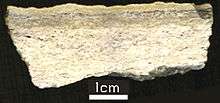Paleosol


In the geosciences, paleosol (palaeosol in Great Britain and Australia) can have two meanings. The first meaning, common in geology and paleontology, refers to a former soil preserved by burial underneath either sediments (alluvium or loess) or volcanic deposits (volcanic ash), which in the case of older deposits have lithified into rock. In Quaternary geology, sedimentology, paleoclimatology, and geology in general, it is the typical and accepted practice to use the term "paleosol" to designate such "fossil" soils found buried within either sedimentary or volcanic deposits exposed in all continents as illustrated by Rettallack (2001),[1] Kraus (1999),[2] and other published papers and books.
In soil science, paleosols are soils formed long periods ago that have no relationship in their chemical and physical characteristics to the present-day climate or vegetation. Such soils form on extremely old continental cratons and as small scattered localities in outliers of ancient rock.
Properties
Because of the changes in the Earth's climate over the last fifty million years, soils formed under tropical rainforest (or even savanna) have become exposed to increasingly arid climates which cause former oxisols, ultisols or even alfisols to dry out in such a manner that a very hard crust is formed. This process has occurred so extensively in most parts of Australia as to restrict soil development - the former soil is effectively the parent material for a new soil, but it is so unweatherable that only a very poorly developed soil can exist in present dry climates, especially when they have become much drier during glacial periods in the Quaternary.
In other parts of Australia, and in many parts of Africa, drying out of former soils has not been so severe. This has led to large areas of relict podsols in quite dry climates in the far southern inland of Australia (where temperate rainforest was formerly dominant) and to the formation of torrox soils (a suborder of oxisols) in southern Africa. Here, present climates allow, effectively, the maintenance of the old soils under climates which they could not actually form if one were to start with the parent material on which they developed in the Mesozoic and Paleocene.
Paleosols in this sense are always exceedingly infertile soils, containing available phosphorus levels orders of magnitude lower than in temperate regions with younger soils. Ecological studies have shown that this has forced highly specialised evolution amongst Australian flora[3] to obtain minimal nutrient supplies. The fact that soil formation is simply not occurring makes ecologically sustainable management even more difficult. However, paleosols often contain the most exceptional biodiversity due to the absence of competition.[4]
Applications
Paleoclimate reconstructions
Paleosols record certain aspects of the climate in which they formed. Quaternary paleosols in particular have been widely used to determine past environmental conditions, such as paleo-precipitation and mean temperatures.[5]
Paleobotany
Paleosols are an important archive of information about ancient ecosystems and various components of fossil soils can be used to study past plant life. Paleosols often contain ancient plant materials such as pollen grains and phytoliths, a biomineralized form of silica produced by many plants such as grasses. Both pollen and phytolith fossils from different plant species have characteristic shapes that can be traced back to their parent plants.[6] Over long geological time scales, phytoliths may not necessarily be preserved in paleosols due to ability of the poorly crystalline silica to dissolve.
Another indicator of plant community composition in paleosols is the carbon isotopic signature. The ratio of different carbon isotopes in organic matter in paleosols reflects the proportions of plants using C3 photosynthesis, which grow in cooler and wetter climates, versus plants using C4 photosynthesis, which are better adapted to hotter and drier conditions.[7] Other methods for detecting past plant life in paleosols are based on identifying the remains of leaf waxes, which are slow to break down in soils over time.[8]
See also
References
- ↑ Retallack, G.J., 2001, Soils of the Past, 2nd ed. New York, Blackwell Science. ISBN 0-632-05376-3
- ↑ Kraus, M.J., 1999, Paleosols in clastic sedimentary rocks: their geologic applications, Earth Science Review 47:41-70.
- ↑ Tim F. Flannery, The Future Eaters: An Ecological History of the Australian Lands and People; published 1994 by George Braziller
- ↑ David Tilman; Resource Competition And Community Structure; published 1982 by Princeton University Press
- ↑ Maher, B. A. (2016). Palaeoclimatic records of the loess/palaeosol sequences of the Chinese Loess Plateau. Quaternary Science Reviews, 154, 23-84.
- ↑ Kurmann, M. H. (1985). An opal phytolith and palynomorph study of extant and fossil soils in Kansas (USA). Palaeogeography, Palaeoclimatology, Palaeoecology, 49(3), 217-235.
- ↑ Cerling, T. E. (1984). The stable isotopic composition of modern soil carbonate and its relationship to climate. Earth and Planetary Science Letters, 71(2), 229-240.
- ↑ Zhang, Z., Zhao, M., Eglinton, G., Lu, H., & Huang, C. Y. (2006). Leaf wax lipids as paleovegetational and paleoenvironmental proxies for the Chinese Loess Plateau over the last 170kyr. Quaternary Science Reviews, 25(5), 575-594.
External links
| The Wikibook Historical Geology has a page on the topic of: Soils and paleosols |